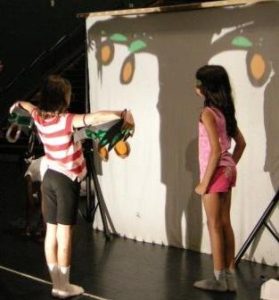Over the next few weeks, 950 students in six Title 1 elementary schools here in Montgomery County will experience the magic and fun of art—visual arts, dance, music, theater and storytelling, to be precise. It’s all part of the Summer ELO-CARE program offered to select students in Montgomery County Pubic Schools. This is the ninth year that AHCMC has had the privilege to work with MCPS on this very worthy program. From time to time we’ll be bringing you reports from the teaching artists who are part of this program to enhance learning skills in children identified as at-risk for academic failure. ELO-CARE is made possible by a grant from the 21st Century Community Learning Centers Program and the Maryland State Department of Education.
Week 1: July 5 – July 8, 2001
Setting Up Summertime Magic
(To be read in a proper British accent, documentary style)
By Erika Conner, Theater
For the students, the theater portion of Extended Learning Opportunities (ELO) is filled with fun, creativity and imagination. However, before the magic begins in the classroom, the Creative Kids artists and staff work together to create a space that is nurturing, inspiring an d educational.
d educational.
Beginning with an eclectic collection of children’s books Creative Kids sets the stage for young readers to be engaged in the wonderful world of reading. The books include folktales that have important universal themes of greed, kindness, acceptance as well as having colorful characters and worldly settings allow great opportunities for kids to use their imaginations and enrich their own character development. Stories like FERDINAND THE BULL and ANANSI tales are rich with characters and traits that all children can easily access and enjoy.
As an artist entering a new room for the first time I think to myself: “Erika, is this space large enough for you to make a spider acting space with your magic masking tape or should you make a rectangle for the first week?”
After I’ve made that initial nail-biting choice, I begin the sticky task of unraveling the spool of tape and applying it to the floor. “Nail-biting” you may laugh—as I am! But, as an educator and an artist, I’ve learned to appreciate the power of tape on the floor. The tape is magical because it attracts everyone young and old, it beckons people, and it makes them ask (in their minds or out loud) “What is this for? What are we going to do?”
Usually while they are questioning the tape on the floor they are entering the room at a snail’s pace, thus, allowing me enough time to size everyone up. So in addition to being a defined space for bringing our stories to life, the tape is a wonderful tool for crowd control (bit of a stretch but it works for me).
After I’ve identified the location for where the magic will occur, (the acting space), I think about where to place the classroom behavior expectations. This vital piece of classroom legislation is placed prominently on the bulletin at the eye level of the average second-grader where it can be viewed from every seat. As I will be working with grades K-3 this summer, placement of classroom documents must be well thought out.
In addition to classroom regulations, I’ve place the more fun documentations on another bulletin board. These fun documents include the five tools for acting. The placement of the documents on either bulletin board creates a well-balanced Yin/Yang affect in the classroom (the balance is probably more for me than anyone else).
Next, I locate a reflection corner and I furnish it with a chair, just in case someone needs some time to think. I look around the room to make sure the desired ambiance has been created. Yes! It works!
I take a sheet of chart paper from my magic box along with several markers and draw a colorful series of faces and scribe the words: “WELCOME TO ACTING” with confetti-like dots in the background. This final document is boldly placed on the blackboard signaling that the magic has begun!
Erika Conner is a teaching artist with Creative Kids. Creative Kids is an inventive and inspiring arts-based and arts integrated programs designed to address state standards and meet the needs of all students in order to help them reach their full potential as a learner and as a creative individual ready to meet the challenges of the 21st Century.
